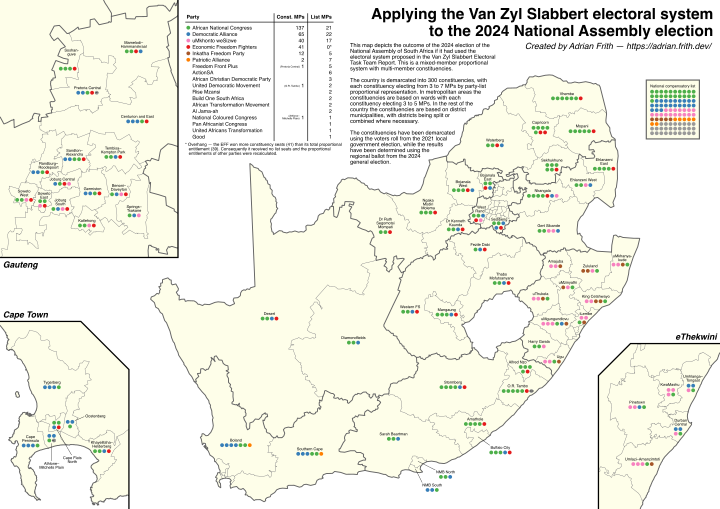Applying the Van Zyl Slabbert electoral system in 2024
Please note that I write here in my personal capacity. The views expressed here are not those of my employer.
Following last week’s post in which I imagined the results of a mixed-member proportional electoral system with single-member constituencies, I thought it would also be interesting to look at the electoral system proposed in 2003 by the Report of the Electoral Task Team, also known as the “Van Zyl Slabbert Report”.
This system is also a mixed-member proportional (MMP) system, but with larger multi-member constituencies. The country is demarcated into constituencies electing between 3 and 7 members each, with a total of 300 constituency MPs. A further 100 MPs are elected from national compensatory party lists to restore the overall proportionality of parties in the National Assembly.
The results of the 2024 election had it been held under such a system are depicted in the following map.

Demarcation process
Under this system there are a fixed number of 300 seats for constituency MPs, which are allocated to constituencies in proportion to the size of the constituency voters’ roll.
Each district municipality serves as a constituency, unless it would have fewer than 3 or more than 7 MPs. Districts which would fewer than 3 MPs are merged with neighbouring districts; on the present numbers this affects the Western Cape and Northern Cape, as well as parts of the Eastern Cape and Free State. Districts which would have more than 7 MPs are divided based on the boundaries of the local municipalities; this affects Bojanala Platinum in the North West and Ehlanzeni in Mpumalanga.
Metropolitan municipalities are demarcated into constituencies based on ward boundaries, with each constituency ideally electing 4 members; where necessary a metropolitan constituency can elect 3 or 5 members. With the current voters’ roll numbers, two metros (Buffalo City and Mangaung) are small enough to be single constituencies. Nelson Mandela Bay is divided into two constituencies, Tshwane into four, Ekurhuleni and eThekwini into five each, and Cape Town and Johannesburg into six each.
Election results
I used the regional ballot results from the 2024 general election to calculate the seat allocation for each of the demarcated constituencies. The results came out as follows.
| Party | Vote share | Constituency seats won |
|---|---|---|
| ANC | 39.3% | 137 |
| DA | 21.8% | 65 |
| MK | 14.1% | 40 |
| EFF | 9.8% | 41 |
| IFP | 4.3% | 12 |
| PA | 2.2% | 2 |
| VF+ | 1.5% | 1 |
| UDM | 0.5% | 1 |
| NCC | 0.3% | 1 |
| Others | 4.7% | 0 |
When compared with the single-member system I showed last week, there is much greater variety in representation. In the rural areas (excluding KZN and the Western Cape) the ANC still predominates, but it no longer has a clean sweep of constituency seats. We now see rural representation for the DA and the EFF as well. Conversely in the Western Cape we see the ANC winning some seats in the DA-dominated areas.
In KZN, where the vote split four ways between MK, IFP, ANC and DA, we see some very mixed constituencies including some with representation for all four parties. In Gauteng there is a similar result with constituencies split between ANC, DA, EFF and MK.
In some areas smaller parties manage to win seats by having a local concentration of supporters. The Patriotic Alliance (PA) wins two seats in the rural Western Cape, while the National Coloured Congress (NCC) wins one seat in the Cape Town metro constituency of Athlone–Mitchell’s Plain. The United Democratic Movement wins one seat in O.R. Tambo constituency because of its voter base in the area around Mthatha. The Freedom Front Plus wins a seat in Pretoria Central.
A note on the EFF seats
A particularly interesting situation arises with the EFF’s seat allocation. By the proportionality calculation, the EFF is entitled to 39 of the total 400 seats in the National Assembly. However it wins 41 of the 300 constituency seats. This occurs because there are many constituencies where the EFF gets 10–15% of the vote, but wins 1 of 4 or 5 seats in the constituency, because of the way that the Largest Remainder Method allocates seats to parties that haven’t reached a full quota of votes.
In this case, the system proposed in the Van Zyl Slabbert Report requires that the EFF be awarded no seats from the national compensatory list, and the proportionality calculation be redone with the EFF’s votes and seats excluded. This is why the map above shows the EFF with 41 seats rather than the 39 it won in reality, and the ANC and MK corresponding with one fewer seat each.